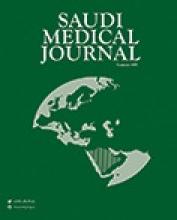Abstract
OBJECTIVE: This study aims at characterizing the hemostatic changes, in a large cohort of Saudi Arab patients with acute coronary syndromes.
METHODS: We consecutively enrolled 389 patients (unstable angina [UA]: n=181; myocardial infarction [MI]: n=208) in this study at King Khalid University Hospital, Riyadh, Kingdom of Saudi Arabia in the period from April 2000 to November 2001. We collected blood samples before coronary angiography. Controls (n=101) were healthy males and females. All hemostatic assays were undertaken using enzyme linked immunosorbent assay based techniques and commercial kits.
RESULTS: The mean plasma levels of both bound and free tissue factor pathway inhibitors (TFPI) were significantly higher and to comparable levels, in patients with MI and UA, than in healthy control levels. Markers of thrombin generation: the mean levels of prothrombin fraction 1+2, thrombin antithrombin complexes, and D-Dimer were very significantly elevated in the 2 patients groups than in controls. Proteins C and antithrombin III showed statistically significant reduction especially in patients with MI. Plasminogen activator inhibitor levels were significantly elevated in the 2 patient groups, but were higher in MI patients. The mean levels of fibrinogen and D-Dimer as well thrombin antithrombin complex were higher and the levels of free tissue factor pathway inhibitor were lower in patients with 3-vessel coronary artery disease than those with single and double vessel disease.
CONCLUSION: The results of this study confirm the existence, and to a similar extent, of a hypercoagulable state in Saudi patients with MI than UA and in those with 3-vessel coronary artery disease than those with one or 2-vessel disease.
- Copyright: © Saudi Medical Journal
This is an open-access article distributed under the terms of the Creative Commons Attribution-Noncommercial-Share Alike 3.0 Unported, which permits unrestricted use, distribution, and reproduction in any medium, provided the original work is properly cited.






